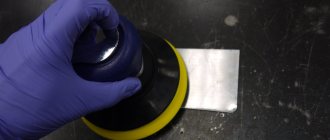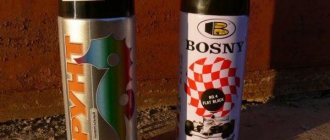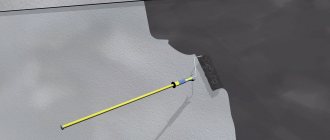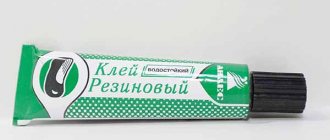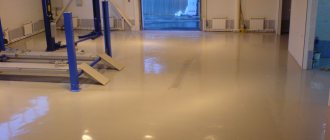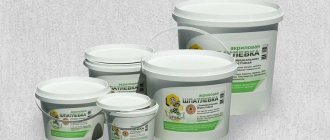Few car owners have not had time to appreciate such an invention as epoxy primer in their driving practice. Its use in the restoration and care of car parts, as well as when working with other metal surfaces, will extend the life of the product, improve its protective properties and facilitate uniform, smooth painting.
What is epoxy primer?
This paint and varnish material is intended for coating metal surfaces. At its core, it is a two-component polymer substance that, when hardened, has the property of forming a breathable coating, absolutely non-porous, providing excellent intermolecular cohesion (adhesion) of materials of different structures. Epoxy-based primer is actively used to cover car underbody or to “reconcile” different coatings that are otherwise incompatible due to conflicting textures.
Properties of epoxy primer
The uniqueness of this coating lies in its characteristics, the skillful use of which can save us from unnecessary headaches. Epoxy enamel is a primer that protects metal surfaces from many negative environmental influences due to its following properties:
- Strength
: this coating can withstand severe mechanical loads without losing integrity. - Uniformity when curing
: epoxy primer dries evenly over the entire area of application, leaving no vulnerable spots on the coated surface. - Resistance to temperature changes
: severe frosts or extreme heat do not affect the quality of the enamel, which is especially valuable for car enthusiasts. - Flexibility
: When bending a metal surface treated with epoxy, the coating will not crack, but will take a new shape. - Adhesion
: it adheres well to the most capricious surfaces, such as galvanized or aluminum, preparing them for painting without any problems. - Moisture and breathability
: also suitable for parts that are destined to interact closely with moisture, reliably protecting them from corrosion.
What is epoxy primer used for?
Avid walkers may never know about such a substance. However, epoxy primer for a car, its owner and auto repair shop workers is the basis, a guarantee of long and happy operation of the vehicle. It is used for:
- Creation of anti-corrosion protection for the body. In this case, it also works as a sealant, a base for acrylic coating.
- Reconciliation of structures of different materials on the same plane. Metal that is inconvenient to work with, remnants of old varnish, putty - all of this will be covered at once with epoxy sticky primer, creating a uniform, flat surface for further processing.
- Increasing the strength of the coated plane. The epoxy base will protect the part from mechanical damage and thereby significantly increase its service life.
Pros and cons of epoxy primer
Much has already been said about the advantages of such a coating: these are its hermetic properties and strength and adhesion. In addition, epoxy primer for metal is one of the few paints and varnishes that are absolutely safe for humans and the environment. That is, its advantages also include environmental friendliness. However, it also has one obvious disadvantage - epoxy requires an extremely long time to dry completely.
It takes up to 12 hours for enamel to completely harden, and this is at a temperature of 20°C. It is worth considering that any attempts to speed up this process using, for example, a hair dryer will fail and will only spoil the final result: bubbles and irregularities will appear on the surface. Therefore, when choosing an epoxy primer for your purposes, be patient.
Which is better - epoxy or acid primer?
This enamel is not the only option for the base. Next to epoxy in auto repair shops there is always an acid primer. How are they different? How to choose what to use - epoxy primer or acid primer? Dealing with this is very simple, given the main advantage of acid - the ability to neutralize corrosion. So, in what cases which coating will be optimal:
- Epoxy should only be used on surfaces that are free of rust. Even the initial stage of corrosion under such soil can turn into a disaster - the process will not only not stop, but will also be hidden from view by a dense coating.
- Acidic soil strongly prevents corrosion even when the metal surface is already affected by it. Before applying such a base, the surface should still be cleaned of rust. It is not recommended to use epoxy primer together with acid primer, because it will inevitably neutralize all the beneficial activity of the acid.
Technology of application to concrete surfaces
As is known, concrete (and especially reinforced concrete) is susceptible to atmospheric corrosion. It manifests itself in local crumbling of the surface layers of the material, loss of its strength characteristics, up to the chipping of parts of the concrete coating, which is under constant influence of moisture.
This is typical not only for the exteriors of buildings, but also for interior work, in particular, with self-leveling concrete floors, as well as for concrete tanks intended for storing process water. Therefore, anti-corrosion treatment of concrete is not a luxury, but a condition for ensuring its durability.
Processing conditions
Coating concrete with epoxy primer compositions is done as follows. In the room where the work will be carried out, it is necessary to ensure a temperature of not lower than +15°C. This is due to the fact that the compositions under consideration are based on heterogeneous components - fillers, plasticizing additives, etc., most of which lose their effectiveness at low temperatures.
Limitations also exist for relative humidity indicators. Unlike a car, where the surface being treated is dense, concrete or reinforced concrete always contains micropores, which, when filled with moisture, can damage the finish coating. This is especially important if no subsequent floor treatment is planned.
The surface to be treated is thoroughly cleaned from dust, various grease deposits and dirt. After this, the floor is treated with any type of organic solvent and wiped dry with a rag.
Preparation of the solution
Next, the primer itself is prepared for use: the base composition is mixed until homogeneous, and the amount of hardener specified in the instructions is added to it. The resulting composition is also thoroughly mixed.
At temperatures close to the minimum recommended, the finished primer may have increased viscosity, which is not entirely convenient for working with it. In this case, it is permissible to add a solvent to it in an amount of no more than 5-10% of the total volume.
Application
The composition is applied using a roller, and for large and flat surfaces you can use a spray gun. The finished composition must be applied to the surface within 30-40 minutes, otherwise the composition will thicken and become unsuitable for use.
After drying (under normal conditions, the soil readiness period, according to the certificate, does not exceed 10-12 hours), floor coverings can be glued to the surface of the concrete floor or painted.
Types of epoxy primer
Your eyes widen when you see the racks of paint and varnish products; there are more than ten varieties of enamels alone. All this diversity can be divided into two main types, differing from each other in one significant nuance:
- Epoxy one-component primer
. This type of enamels, which has almost faded into oblivion, is used extremely rarely and mainly by those for whom economy is more important than efficiency. The thing is that it does not contain a hardener, which makes the drying process even longer. - Epoxy two-component primer
. The main player in the base enamels market. 12-hour drying cannot be called fast, however, in this indicator, this type greatly outperforms its one-component relative due to the high-quality hardeners included in the kit.
Features of the material
The epoxy mixture is made from a resin with the addition of special components to improve the protective properties of the material. This coating is mainly used for concrete and metal surfaces . The properties of the primer will depend entirely on the specific type and purpose of the mixture.
Epoxy resin-based primer tolerates sudden temperature changes well and is also resistant to mechanical stress. The material does not delaminate on the surface after application. This primer goes well with paint products based on epoxy resin .
Which epoxy primer to choose?
What do you need to know so as not to make a mistake when choosing one or another enamel when making a purchase in a specialized store? When choosing an epoxy primer, go through this list of tips:
- If the enamel-coated surface will be exposed to extremely low or high temperatures, you need to pay attention to the corresponding markings on the label - different hardeners are used in the composition for heat and frost. For extreme surface corrosion protection, choose a zinc-rich epoxy.
- In the case where the treated surface is concrete, it is worth choosing a soil with the appropriate specifics. Yes, yes, not only metal can be coated with such enamel. Epoxy primer for concrete differs slightly in composition, as stated on its label.
- If you plan to use it to coat metal, the optimal choice would be a two-component enamel, because, as it turned out above, it dries quickly and does not cause unnecessary trouble.
- It may not be obvious, but enamel is also suitable for use on wooden surfaces. For these purposes, one-component epoxy primer is best suited, because its composition allows it to be produced in a form convenient for application to wood - in a spray can.
Epoxy primer in a can
Compactness and convenience are the main advantages of the aerosol form of enamels. A can of epoxy in the garage will provide a quick solution to the problem of minor scratches and damage to the body. Due to the specifics of its composition, two-component enamel is not available in this form, so when buying such a sprayer, remember that inside there is a one-component substance that needs more time to dry. Epoxy aerosol primer simplifies the processing of small parts with complex textures: even micro-cracks and chips on a wooden surface can be easily covered with its help.
Areas of application
Epoxy primers are used for different purposes, depending on their original purpose. Two-component mixtures for metal are used for reliable and durable anti-corrosion protection; they can be applied to the following types of metals:
- galvanizing;
- black metal;
- steel;
- light metals;
- two-component putties based on polyester resins.
They are often used to cover cars.
Epoxy primers, for example, esp 0112, are produced specifically for concrete bases; they are used for the following purposes:
- strengthening concrete structures;
- application to floors and walls before finishing;
- creating a foundation in front of self-leveling floors.
Epoxy Primer Rating
When choosing enamel for your needs, you should first of all focus on the reputation of the manufacturer. The same company can produce both one- and two-component primers with different hardeners in the composition, but only the name of the manufacturer and its rating most clearly indicate the quality of the product. The best today are:
- Epoxy primer Novol
. The flagship on the enamel market. A quick-drying product that reliably protects against corrosion. Its only drawback is the corresponding high price, which is very justified. - Epoxy primer Body
. A working option from the middle price segment. Excellent quality enamel, available in a wide range of forms. Great for non-commercial use in your garage. - Epoxy primer Reoflex
. The most affordable option presented, while performing its function perfectly. Inferior to the flagship in terms of hardening time.
How to apply epoxy primer?
So, we have decided on the choice of enamel. How can you apply it correctly after this? There are a number of useful tips in this regard:
- Take care of personal protective equipment - chemical components should not come into contact with exposed skin and, especially, mucous tissues of the body.
- Clean the surface first. Applying epoxy primer to rust is strictly not recommended.
- Dilute the substance as described in the instructions.
- The base layer of enamel must be extremely thin. After 15 min. you need to apply the next layer on top of it, and after the same period of time - the third and final one.
- Movements during application should be smooth, so that the coating is uniform, without fragmentary thickenings. The specifics of this process also depend on the tool used for priming.
How to apply epoxy primer?
If everything is clear with one-component enamel sold in cans, then how to work with its other types? Epoxy anti-corrosion primer can be applied in several ways:
- With a brush
. Good for small parts and surfaces with a small area. - With a roller
. They can already roam around large areas. - Spray gun
. This is a special tool for quickly coating large parts. It should be taken into account that when using it, smudges may appear, which need to be sanded after the soil hardens.
How long does it take for epoxy primer to dry?
The hardening time of enamel depends on many factors:
- From the presence of hardeners
: a one-component primer without them dries twice as long. - On temperature
: soil that hardens at 20°C requires 12 hours of rest, and soil that freezes at 60°C requires only 4 hours. - From layer thickness
: it is better not to touch thick-layer epoxy primer for several hours longer than a thin coating. - From the manufacturer
: low-quality enamels can dry for years, but never harden.
How to clean epoxy primer?
It happens that enamel accidentally ends up on surfaces that were not intended for this purpose. Or an imprudent craftsman applied epoxy primer over the rust, and in order to save the part, you need to get rid of this coating. The surest option is to do this mechanically: using sandpaper or an abrasive sponge. In addition, epoxy primer can be washed with a special product - paint remover. Most manufacturers in this market have such a substance, so finding it will not be difficult.
Two-component primers
Two-component EP primers are often used during concrete and metal protection work. It is two-component mixtures that are of high quality, as confirmed by the corresponding certificate, and they also have excellent performance properties that exceed the characteristics of single-component soils.
Many car owners prefer to use the two-component type. In addition to the fact that this type has excellent protective characteristics, after such mixtures have dried, metal products can be painted using special pastes that improve the shade of the final paint layer.

